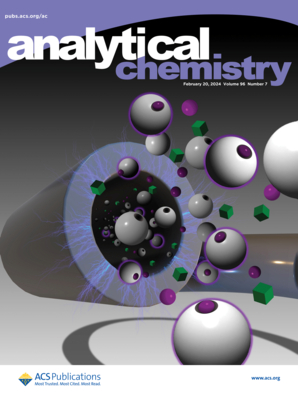Ru(phen)32+-Sensitized GaN-Gated Organic Photoelectrochemical Transistor for Sensitive and Selective Detection of Human Papillomavirus DNA.
IF 6.7
1区 化学
Q1 CHEMISTRY, ANALYTICAL
引用次数: 0
Abstract
Benefiting from the well-matched energy levels between Ru(phen)32+ and GaN, and the ability of Ru(phen)32+ to intercalate into the grooves of double-stranded DNA (dsDNA), an innovative organic photoelectrochemical transistor (OPECT)-based biosensor has been developed for the detection of human papillomavirus 16 (HPV-16), which was chosen as a model target. Trigger DNA immobilized on the gold-coated GaN surface can initiate a hybridization chain reaction (HCR), generating long-stranded dsDNA, which can be used to load a large amount of Ru(phen)32+. The produced dsDNA can also serve as a π-π-stacked hole-transporting nanowire, enhancing the efficiency of the hole transport between GaN and Ru(phen)32+. Under light irradiation, efficient energy level matching between GaN and Ru(phen)32+ promotes the transport efficiency of photogenerated carriers, leading to a significant increase in the drain-source current (IDS). In the presence of HPV-16, the CRISPR/Cas12a system is activated and the immobilized trigger DNA is cleaved, thereby preventing the formation of dsDNA through HCR. As a result, a smaller amount of Ru(phen)32+ is immobilized on the electrode surface, leading to a reduction in the output signal. The signal change exhibits a linear relationship with the target concentration in the range of 10.00 fM to 10.00 nM, achieving a detection limit as low as 2.88 fM, which is much better than that of the corresponding photoelectrochemical (PEC) biosensor. The system demonstrates excellent sensitivity and specificity in clinical sample analysis.Ru(phen)32+敏化gan门控有机光电电化学晶体管用于人乳头瘤病毒DNA的灵敏和选择性检测。
利用Ru(phen)32+与GaN之间良好匹配的能级,以及Ru(phen)32+插入双链DNA (dsDNA)凹槽的能力,开发了一种新型的基于有机光电化学晶体管(OPECT)的生物传感器,用于检测人乳头瘤病毒16 (HPV-16),并将其作为模型靶点。在金包覆的GaN表面固定的触发DNA可以引发杂交链反应(HCR),生成长链dsDNA,可以用来装载大量的Ru(phen)32+。制备的dsDNA还可以作为π-π堆叠的空穴传输纳米线,提高了GaN和Ru(phen)32+之间空穴传输的效率。在光照射下,GaN和Ru(phen)32+之间的高效能级匹配促进了光生载流子的输运效率,导致漏源电流(IDS)显著增加。在HPV-16存在下,CRISPR/Cas12a系统被激活,固定的触发DNA被切割,从而阻止通过HCR形成dsDNA。结果,更少量的Ru(phen)32+被固定在电极表面,导致输出信号减弱。在10.00 fM ~ 10.00 nM范围内,信号变化与目标浓度呈线性关系,检测限低至2.88 fM,远优于相应的光电化学(PEC)生物传感器。该系统在临床样品分析中具有良好的敏感性和特异性。
本文章由计算机程序翻译,如有差异,请以英文原文为准。
求助全文
约1分钟内获得全文
求助全文
来源期刊

Analytical Chemistry
化学-分析化学
CiteScore
12.10
自引率
12.20%
发文量
1949
审稿时长
1.4 months
期刊介绍:
Analytical Chemistry, a peer-reviewed research journal, focuses on disseminating new and original knowledge across all branches of analytical chemistry. Fundamental articles may explore general principles of chemical measurement science and need not directly address existing or potential analytical methodology. They can be entirely theoretical or report experimental results. Contributions may cover various phases of analytical operations, including sampling, bioanalysis, electrochemistry, mass spectrometry, microscale and nanoscale systems, environmental analysis, separations, spectroscopy, chemical reactions and selectivity, instrumentation, imaging, surface analysis, and data processing. Papers discussing known analytical methods should present a significant, original application of the method, a notable improvement, or results on an important analyte.
 求助内容:
求助内容: 应助结果提醒方式:
应助结果提醒方式:


